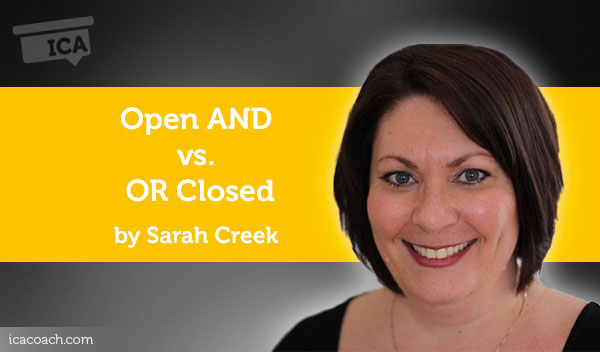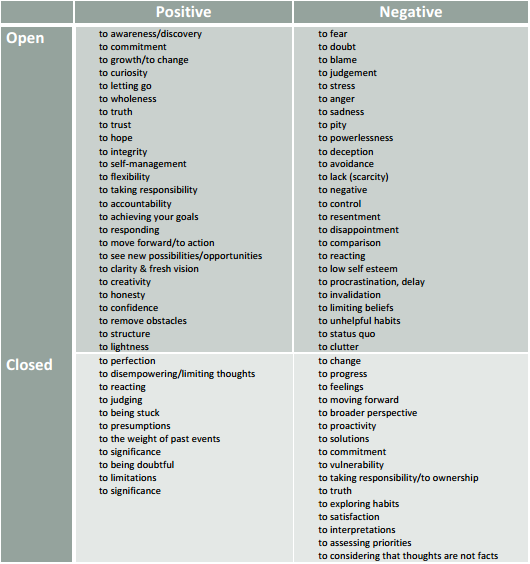A Coaching Power Tool Created by Sarah Creek
(Simplicity Life Coaching for Visionary Women, CANADA)
Open AND/OR closed is a common theme in coaching. It describes a state of heart, mind, soul; it also describes an opportunity for action. Both have 2 perspectives to consider: the positive effect, and the negative one.
A coaching example
Design A Clear Objective
Ella brings a conversation to the coaching space: she wants to explore a new job opportunity. Ella is open. In supporting her, I may ask what opening this door of opportunity could do for her?
As Ella openly shares, I carefully listen and may hear that she is:
- excited about the promotion (open to new possibilities)
- enjoys the travel possibilities (open to new territories and experiences )
- is ready for more responsibility (open to a promotion)
I may also hear that she is:
- doubtful she will get the promotion (open to doubt)
- fearful she will not be “enough “ (open to fear and self doubt)
- concerned with perfection (closed to authenticity)
Ella decides that she wants to focus our session on the travel possibilities. She wants to explore her travelling dreams. She is open to new territories, experiences, making new memories. Ella has an open mind, heart and soul.
Present Reality
Ella freely shares, and gets awareness that in order to enjoy the travelling possibilities, she needs get the job! But ohhh…. she is so concerned that she won’t be good enough (she might be closed to truth, open to doubt). I support Ella by listening, offering space for her to express herself and mirroring back to her what I am hearing.
As Ella continues to share, she become aware of her nagging sense of the self-doubt which is getting in the way of her pursuing this job opportunity and enjoying the travel opportunities and benefits. This is the real coaching issue. Ella has opened the door to this awareness. My silence gives her the space to see her doors.
I may then ask some questions to help Ella decide what she wants to do about the door:
- Which door do you want/need to open/close?
- Which door is currently ajar that you can either open or close?
Ella identifies tat the door of travel opportunity is ajar; the door to self-doubt and fear is fully open; the door to confidence and trust is shut tight. She is now aware of where she is at. She is “in the hallway”, and has some choices.
Explore
As Ella stands in the hallway, in front of her doors, she explores her options. With keeping her goal of wanting to be able to travel, Ella invites the coach into her “self doubt” room. This self doubt is a deep seated belief Ella has carried for a long time. This is a room she knows well. A room that has kept her captive most of her life. For the first time, Ella realizes that there is a door to this room. Although she has felt trapped in this room of self doubt and fear, she becomes aware that the door is fully open. She explores the possibility of walking out of that room and closing the door behind her.
Ella chooses to explore how to close the door to the voices that tell her she is not enough, she will fail. etc She unlocks her truth and opens the door to the truth of who she is – a strong, powerful, resourceful woman who has all it takes to get the job and enjoy the travelling perks of it. Ella chose which keys (tools) to use to open the door of truth and close the door of self doubt/fear.
KEYS are a means of gaining or preventing entrance or control. Just as a house key is keyed to a lock, so is the key needed for each of the client’s doors. The client is resourceful and able to use her key of choice to unlock some doors, and lock some up for good. When the client is in the hallway or in front of her doors, here are some questions I may ask her:
- How do you feel about the door that is in front of you?
- Where does this door lead to?
- What if the door was wide open? What would be the first thing you would do?
- What is preventing you from opening /closing the door?
- Which new door can you open/close? Which old door can you open/close?
- What is motivating you to open/close the door?
- Can you open/close the door? Is it locked? Jammed? Sealed shut? Is it wide open?
- Are you locked in/out
- What do you see through the door?
- Which key do you need?
- How would you like to proceed?
- What would it look like if you opened/closed the door?
- What is the first step you need to take?
- How will this action (open/close) support your goal
New Steps
Finally, as Ella positions herself to take steps towards her goal, she flings open the doors of opportunity, closes the door to her limiting thoughts and is able to let go of disempowering beliefs. Her new steps include clinging to her new “true” belief and surrounding herself with support and accountability to achieve her goal. She has fortified her personal foundation. Through coaching, she has realized that making this shift enables her to realize her travelling dreams. Her fortified foundation can support the weight of her dreams and travelling journey. Ella is now free to be who she was created to be, doing what she loves doing!

